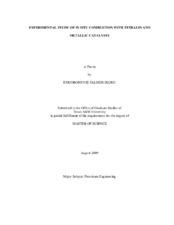| dc.description.abstract | Experimental studies showed the feasibility of adding metallic catalysts and
tetralin for the upgrade and increased recovery of heavy oil during the in situ combustion
process. Further experimental studies also showed the applicability of in situ combustion
as a viable method of upgrading and improving recovery of intermediate oils.
Three successful experimental runs were performed with heavy oil from Mexico
(10.1 degrees API gravity). The first run was the control run without the addition of tetralin or
metallic catalysts; the second run used heavy oil premixed with 3 wt% tetralin and
500ppm nickel catalyst; and the third run was with heavy oil premixed with 3 wt%
tetralin and 500ppm iron catalyst. For the three runs, the cell production pressure was
kept constant at 300 psig. The combustion cell was placed in a vacuum jacket and set to
a temperature of 60 degrees C. For the only successful run with the intermediate Texas oil
(22.0 degrees API gravity), the production pressure was also kept constant at 300 psig but the
vacuum jacket temperature was set to a reservoir temperature of 40oC. During the runs
for both oils, samples of produced oils and combustion flue gases were collected at regular intervals for analysis. These analyses included determination of oil viscosity and
density, oil recovery, combustion front velocity, and apparent H/C ratio.
Experimental results for the intermediate oil run, the oil gravity increased by 6
points showing the upgrading effects of in situ combustion on intermediate oils. Also,
the high average combustion temperatures observed during the run indicated that in situ
combustion may be applicable to reservoirs of similar characteristics to the intermediate
Texas oil reservoir.
Heavy oil experimental run results indicated that the use of tetralin and metallic
catalysts increase the average combustion front temperature from 484 degrees C to 501 degrees C for the
run with nickel catalysts, and from 484 degrees C to 492 degrees C for the run with iron catalysts. These
results also show an increase in produced oil recovery from 83% to 90% of oil initially
in place for the nickel catalyst run, and 83% to 86% of oil initially in place for the iron
catalyst run. | en |


